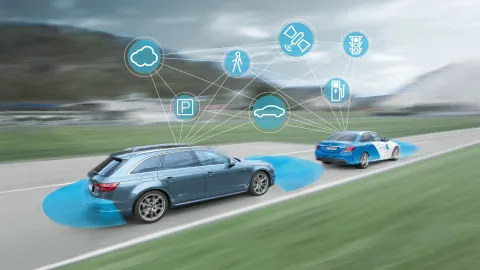Developing ADAS/AD systems for customer requirements is just as complex as taking into account the relevant national and international regulations, such as the General Safety Regulation (GSR) in Europe or the specifications from the European New Car Assessment Programme (NCAP). Modern ADAS/AD features must be able to map every facet of these requirements.

Differing Standards
Whether in the USA, Europe, or Asia – every market has specific standards for ADAS/AD systems. There are also global standards, regulations, and legal frameworks (e.g. NCAP, ISO, etc.) that must be met.
Strategies for Avoiding Accidents
Legal specifications already focus on active strategies for avoiding accidents. For example, the lack of an AEB (Automated Emergency Braking) would considerably reduce the safety rating for a vehicle. The updates to GSR 2022 have further intensified the safety requirements in Europe.
High Level of Customer Acceptance
We place great importance on designing ADAS/AD systems in such a way that they can be regarded by the user as a valuable improvement to comfort or safety. Our aim is for the feature to provide optimal support for the driver, without distracting or influencing the desired driving experience.
Low False Rate
False reactions from ADAS/AD systems lower customer acceptance. Therefore, our aim is to avoid unwanted reactions by the systems through the lowest possible level of false negative and false positive rates.
Optimal Performance
We design the driver assistance systems and automated driving systems in such a way that they show the desired behavior and function reliably in all conditions - including extraordinary ones.

Our primary objective is to develop effective, customer-friendly solutions in line with market requirements. To do so, we have a range of established methods, processes, and tools available to you.
- Standardization with databases: This allows specific designs to be accessed in a swift and affordable manner. That is the basis for flexible customer-specific adjustments.
- Creation of market-specific key performance indicators (KPIs): This enables us to increase customer acceptance in the relevant markets.
- Use case documents: These are our most important foundations - this is where use cases are summarized and main expectations to a feature are raised.
- Definition of the logical architecture: We use diagrams such as feature state or feature flowcharts to enter system statuses, status transitions, and transition conditions for you.
- Requirement document: In this final document, we define the precise requirements for the ADAS/AD system to fulfill the required functionality.
Our expertise allows us to provide you with a carefully thought-through, expedient methodology for the entire process chain at all levels – from the definition of requirements for the automated driving system, to software, function, and vehicle tests, and targeted tracing and evaluation.
Personalization and Market Adjustment
With our experience and flexibility, we know precisely how to fulfill your requests and the requirements of the market in an optimal way – locally and internationally.
Traceability
We document all processes from the definition of requirements to the test results. Therefore, the entire process is seamless and you can trace it back at all levels.
Key Performance Indicators (KPIs)
We define target values that use clear, numeric values to show you the performance we expect from a system. The performance is then measured and evaluated in tests.
Use Case Documents
A use case puts the ADAS system in relation to practical situations. Thereby, we define the expectations for the best-possible system behavior. We summarize all use cases for you in our use case documents.
Logical Architecture Diagrams
Graphic illustration shows the states of the functions, possible state transitions, and their transition conditions. One or more flow diagrams are used to demonstrate the internal logic of the function.
Document for KPI Definition
A KPI is a measurable indicator that provides insight into the performance of a specific function. This document provides you with an overview of all KPIs that are required to achieve the requested level of performance of the function.
Requirements Document
This is where we summarize all system requirements in a single document for you. It includes all conditions or capacities that can be tested and that the system must fulfill.
Use Case ADAS System Design
DownloadRelated Topics
We are constantly working on new solutions. The following might be interesting for you:






